DEAREST, DIR. PETER CHAN (2014)
Shenzhen Railway Station, Luohu District, Shenzhen
The movie Dearest was directed by Peter Chan, which focuses on a severe social issue to the point of stifling: children abduction. Tian Wenjun and Lu Xiaojuan are a divorced couple living in Shenzhen, and their son, Tian Peng is the only bond between them. However, Tian Peng was abducted by human traffickers accidentally. Therefore, the couple embarked on an arduous journey to find their son and finally found Tian Peng in a remote rural village. Meanwhile, another main line of the story unfolds. Her husband deceived Li Hongqin, a rural woman, into adopting two abducted children, including Tian Peng. In the end, Tian Peng returned to his biological parents, and Li Hongqin lost custody of the two adopted children.
The film has two obvious plot turning points. The first one is when Tian Wenjun realized that someone had abducted his son while the police did not file a case because the child had not been missing for 24 hours. Another one is when Li Hongqin went to Shenzhen alone to fight for custody of her daughter, who is the other adopted child. The director arranged both scenes at Shenzhen Railway Station, a symbol of the hustle and bustle in real life. It is a transportation hub linking Shenzhen with other cities, which appears to be very wide and bright in reality. But in the film, Shenzhen railway station works as a miniature symbol of Shenzhen’s modernization, which expresses the protagonist’s different emotions and circumstances.
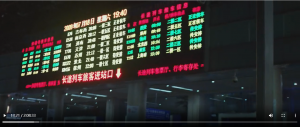 The train schedules. Scenes from the Shouchen Studio’s Dearest 2014, directed by Peter Chan. Still1.
The train schedules. Scenes from the Shouchen Studio’s Dearest 2014, directed by Peter Chan. Still1.
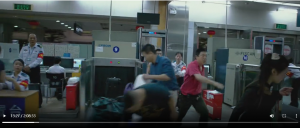
Tian Wenjun went through the security gate in the Shenzhen Railway Station to find his son. Scenes from the Shouchen Studio’s Dearest 2014, directed by Peter Chan. Still2.
When the leading male character searched Luohu Railway Station, the film spent several frames on the train schedules. The constantly updated schedule stands out from the characters’ vision and the audience’s visions in the darkness. Rather than take a panorama of the overall architecture of the railway station, the movie zooms in and focuses on the train schedules: trains linking the cities dash hopes of finding the children, and the constant departure reminders add to the anxiety atmosphere. During the search, the director has shot many typical scenes in the railway station, such as the security gates, winding corridors, luggage storage areas, Etc. By contrast, spacious settings such as waiting halls are absent. Those crowded scenes in my mind are a symbol of obstruction, as Tian Wenjun tried his best to go through the people and the obstacles, implying the difficulties in the journey of finding abducted son but also the strong faith of the protagonist to overcome them.
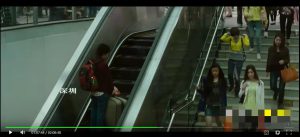
‘Li Hongqin came to Shenzhen alone. Scenes from the Shouchen Studio’s Dearest 2014, directed by Peter Chan. Still3.
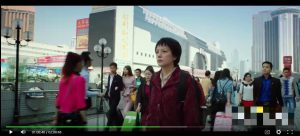
Li Hongqin set out from the railway station, set foot on the tough road for the custody of her daughter. Scenes from the Shouchen Studio’s Dearest 2014, directed by Peter Chan. Still4.
Even though the filming location is still Shenzhen Railway Station, there are different ways of expressions because of the distinct characters and plots in the film. As in the still 3, there is no one on the escalator except Li Hongqin. In contrast, a staircase on the other side bustles with people descending. In another scene (still 4), the director used a rare full shot and kept the camera angle from above. As a result, much of the picture comprised the modern railway station buildings, making the character being dwarfed by the environment. On a sunny afternoon, her shabby old clothes were out of place with the modern train station. These extreme contrasts show her helplessness and loneliness but also represent her love for her adopted children. Even though she is not their biological parent, she would do anything for them.
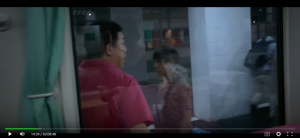

Left: Tian Wenjun checked the departing train for his son. Right: Li Hongqin weaves through the crowds at the railway station. Scenes from the Shouchen Studio’s Dearest 2014, directed by Peter Chan. Still5.
Besides, there are some similarities between these two scenes. The director photographed the characters and their surroundings through the train’s glass or the window’s reflection. This filming technique emphasizes a sense of confinement. The characters seem to be imprisoned and repressed, just as they never get rid of their narrow space and picture cage from beginning to end, and the tragedy of the characters never stops.
Hua Mingyang, 3035830612
You have done a good job in analyzing the storyline in relation to the setting and the filming techniques. It would be great if you have demonstrated more fieldwork analysis, i.e. to compare and contrast the setting in film and in reality. You might also consider using some concepts we have mentioned in class to anchor your report. Lastly, do remember to properly cite all the sources you have used for references.